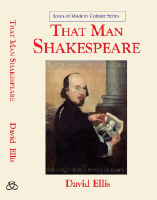ICONS OF MODERN CULTURE
That Man Shakespeare David
Ellis, Professor Emeritus of English Literature, University of Kent at Canterbury
Publication: 19th May 2005, 352 pages . 38 black & white
illustrations, ISBN 978-1-903206-18-8, RRP in UK: £38 [Purchase Online]Before you read yet
another ‘biography’ of Shakespeare, please read this! It will be controversial
in some quarters, perhaps, but it provides a very necessary corrective to the spate of
recent studies.
So little is actually known for certain about the details of Shakespeare’s life and
yet so much has been built on the foundation of a few facts. This book looks at the way
various writers and biographers through the ages and up to the present have used these to
create and develop a national myth which says more about us and our pre-occupations than
it does about Shakespeare.
Appropriately enough, Shakespeare’s first appearance after his death was as a ghost:
one of the glories of the past, he was summoned back from the grave to denounce the
decadent present. It was only with the rise of the historical novel that efforts were made
to provide the public with a more substantial image of their best loved writer. |

|
The difficulty which lay in separating the few known facts of his life from
what E. K. Chambers so aptly termed ‘the Shakespeare mythos’ was one which
historical novelists were entitled to ignore, as were those dramatists who throughout the
19th and 20th centuries contrived have a character called
Shakespeare tread the boards. But from the beginning scholars and biographers were in a
different position and for the latter especially, the inscrutability which Mathew Arnold
celebrated in his famous sonnet, was hardly an option. The various attempts made, in a
variety of different media, to satisfy what was an ever-increasing public curiosity about
‘Shakespeare the man’ are copiously illustrated in this book but it concludes
with an analytic account of the methods contemporary biographers are obliged to employ in
order to meet the demand for knowledge of his beliefs, attitudes and sexual preferences.
The examples cited are a tribute to the four centuries of scholarly endeavour and
imaginative insight which love of Shakespeare has provoked, but they also demonstrate
that, where a national icon is concerned, whereof you do not know thereof you should not
speak is advice which can but fall on deaf ears.Table of Contents
List of Illustrations
Acknowledgements
Note on John Hagan’s Shakespeare’s Portrait
Editor’s Preface
Introduction
Chapter One: Bare Facts
Chapter Two: Myths and Legends
Chapter Three: Shakespeare’s Growing Fame
Chapter Four: Shakespeare in the Romantic and Early Victorian Period
Chapter Five: The Sonnets
Chapter Six: Victorians, Edwardians and Some Others
Chapter Seven: Shakespeare in Our Time: Fiction
Chapter Eight: Shakespeare in Our Time: Biography
Chapter Nine: Conclusion
Envoi: ‘pete the parrot and shakespeare’ from Dom Marquis, archy and
mehitabel, New York, 1927
Bibliography
Index
Shakespeare’s
Portrait by John Hagan, oil on canvas, 2003
The basis of the portrait is
a phrenological drawing (1807) of what was supposed to be Shakespeare’s skull,
attributed to the French natural scientist Georges Cuvier, when he was an admirer of the
Viennese physician and phrenologist Franz-Joseph Gall. Rumour has it that this skull was
taken from its original resting place by an infamous ‘resurrection man’ (later
transported to New Holland) who was acting on behalf of the businessman and amateur
natural scientist, James Deville, and that Deville then carried or sent the skull to
Paris. There it came into the possession of another admirer of Gall, Johan Kaspar
Spurzheim, who later took it to America on one of his many lecture tours in that country.
It has not been seen since.
John Hagan has overlaid the original anatomical
drawings with the Chandos portrait and the Droeshout engraving to arrive at a new
composite portrait of what Shakespeare might have looked like. For a fuller account of
John Hagan’s work, visit the websites: www.geocities.com/jlhagan and
www.linknet.com.au/johnhaga/ |
[Return to Icons of Modern Culture] |